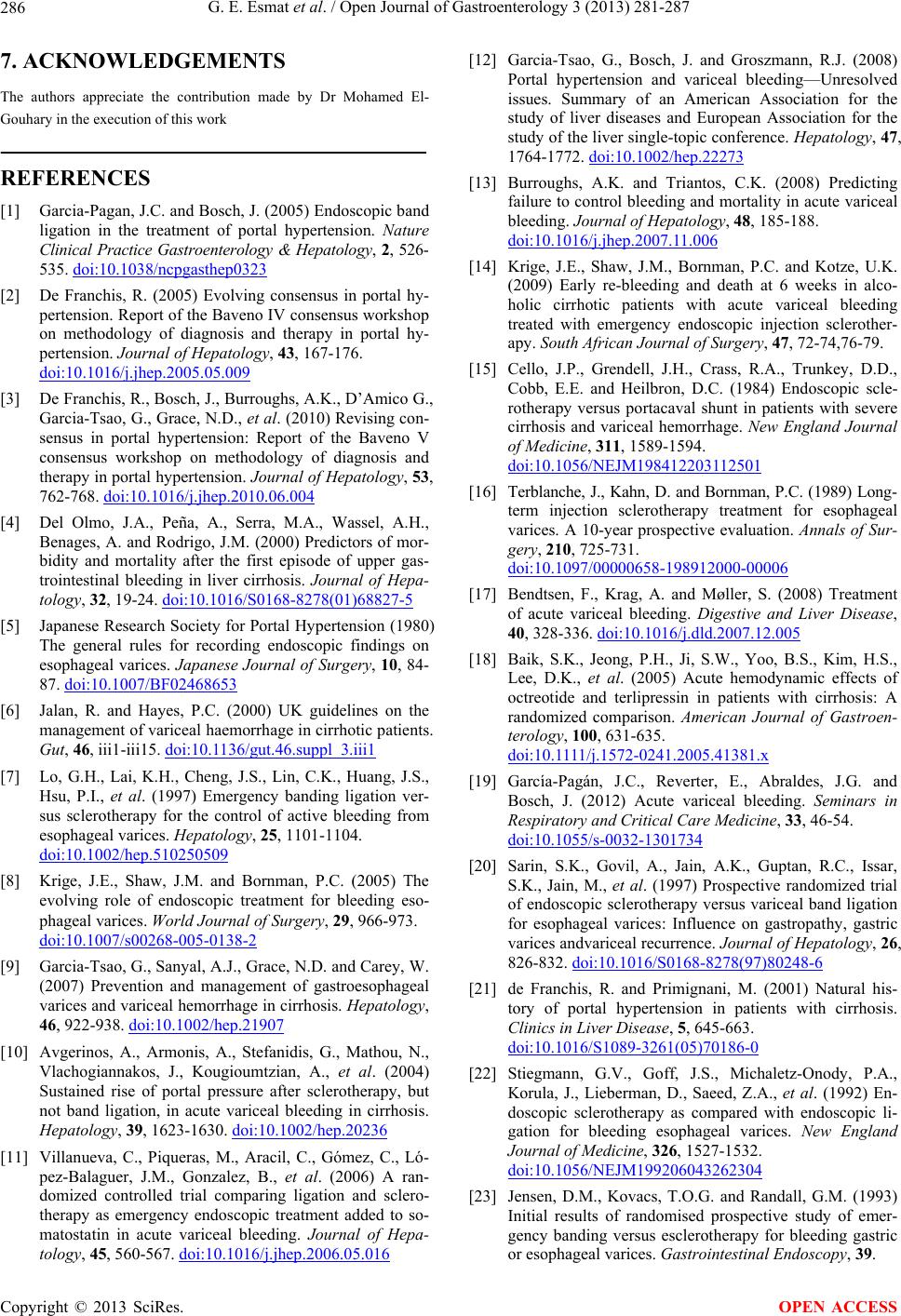
G. E. Esmat et al. / Open Journal of Gastroenterology 3 (2013) 281-287
286
7. ACKNOWLEDGEMENTS
The authors appreciate the contribution made by Dr Mohamed El-
Gouhary in the execution of this work
REFERENCES
[1] Garcia-Pagan, J.C. and Bosch, J. (2005) Endoscopic band
ligation in the treatment of portal hypertension. Nature
Clinical Practice Gastroenterology & Hepatology, 2, 526-
535. doi:10.1038/ncpgasthep0323
[2] De Franchis, R. (2005) Evolving consensus in portal hy-
pertension. Report of the Baveno IV consensus workshop
on methodology of diagnosis and therapy in portal hy-
pertension. Journal of Hepatology, 43, 167-176.
doi:10.1016/j.jhep.2005.05.009
[3] De Franchis, R., Bosch, J., Burroughs, A.K., D’Amico G.,
Garcia-Tsao, G., Grace, N.D., et al. (2010) Revising con-
sensus in portal hypertension: Report of the Baveno V
consensus workshop on methodology of diagnosis and
therapy in portal hypertension. Journal of Hepatology, 53,
762-768. doi:10.1016/j.jhep.2010.06.004
[4] Del Olmo, J.A., Peña, A., Serra, M.A., Wassel, A.H.,
Benages, A. and Rodrigo, J.M. (2000) Predictors of mor-
bidity and mortality after the first episode of upper gas-
trointestinal bleeding in liver cirrhosis. Journal of Hepa-
tology, 32, 19-24. doi:10.1016/S0168-8278(01)68827-5
[5] Japanese Research Society for Portal Hypertension (1980)
The general rules for recording endoscopic findings on
esophageal varices. Japanese Journal of Surgery, 10, 84-
87. doi:10.1007/BF02468653
[6] Jalan, R. and Hayes, P.C. (2000) UK guidelines on the
management of variceal haemorrhage in cirrhotic patients.
Gut, 46, iii1-iii15. doi:10.1136/gut.46.suppl_3.iii1
[7] Lo, G.H., Lai, K.H., Cheng, J.S., Lin, C.K., Huang, J.S.,
Hsu, P.I., et al. (1997) Emergency banding ligation ver-
sus sclerotherapy for the control of active bleeding from
esophageal varices. Hepatology, 25, 1101-1104.
doi:10.1002/hep.510250509
[8] Krige, J.E., Shaw, J.M. and Bornman, P.C. (2005) The
evolving role of endoscopic treatment for bleeding eso-
phageal varices. World Journal of Surgery, 29, 966-973.
doi:10.1007/s00268-005-0138-2
[9] Garcia-Tsao, G., Sanyal, A.J., Grace, N.D. and Carey, W.
(2007) Prevention and management of gastroesophageal
varices and variceal hemorrhage in cirrhosis. Hepatology,
46, 922-938. doi:10.1002/hep.21907
[10] Avgerinos, A., Armonis, A., Stefanidis, G., Mathou, N.,
Vlachogiannakos, J., Kougioumtzian, A., et al. (2004)
Sustained rise of portal pressure after sclerotherapy, but
not band ligation, in acute variceal bleeding in cirrhosis.
Hepatology, 39, 1623-1630. doi:10.1002/hep.20236
[11] Villanueva, C., Piqueras, M., Aracil, C., Gómez, C., Ló-
pez-Balaguer, J.M., Gonzalez, B., et al. (2006) A ran-
domized controlled trial comparing ligation and sclero-
therapy as emergency endoscopic treatment added to so-
matostatin in acute variceal bleeding. Journal of Hepa-
tology, 45, 560-567. doi:10.1016/j.jhep.2006.05.016
[12] Garcia-Tsao, G., Bosch, J. and Groszmann, R.J. (2008)
Portal hypertension and variceal bleeding—Unresolved
issues. Summary of an American Association for the
study of liver diseases and European Association for the
study of the liver single-topic conference. Hepatology, 47,
1764-1772. doi:10.1002/hep.22273
[13] Burroughs, A.K. and Triantos, C.K. (2008) Predicting
failure to control bleeding and mortality in acute variceal
bleeding. Journal of Hepatology, 48, 185-188.
doi:10.1016/j.jhep.2007.11.006
[14] Krige, J.E., Shaw, J.M., Bornman, P.C. and Kotze, U.K.
(2009) Early re-bleeding and death at 6 weeks in alco-
holic cirrhotic patients with acute variceal bleeding
treated with emergency endoscopic injection sclerother-
apy. South African Journal of Surgery, 47, 72-74,76-79.
[15] Cello, J.P., Grendell, J.H., Crass, R.A., Trunkey, D.D.,
Cobb, E.E. and Heilbron, D.C. (1984) Endoscopic scle-
rotherapy versus portacaval shunt in patients with severe
cirrhosis and variceal hemorrhage. New England Journal
of Medicine, 311, 1589-1594.
doi:10.1056/NEJM198412203112501
[16] Terblanche, J., Kahn, D. and Bornman, P.C. (1989) Long-
term injection sclerotherapy treatment for esophageal
varices. A 10-year prospective evaluation. Annals of Sur-
gery, 210, 725-731.
doi:10.1097/00000658-198912000-00006
[17] Bendtsen, F., Krag, A. and Møller, S. (2008) Treatment
of acute variceal bleeding. Digestive and Liver Disease,
40, 328-336. doi:10.1016/j.dld.2007.12.005
[18] Baik, S.K., Jeong, P.H., Ji, S.W., Yoo, B.S., Kim, H.S.,
Lee, D.K., et al. (2005) Acute hemodynamic effects of
octreotide and terlipressin in patients with cirrhosis: A
randomized comparison. American Journal of Gastroen-
terology, 100, 631-635.
doi:10.1111/j.1572-0241.2005.41381.x
[19] García-Pagán, J.C., Reverter, E., Abraldes, J.G. and
Bosch, J. (2012) Acute variceal bleeding. Seminars in
Respiratory and Critical Care Medicine, 33, 46-54.
doi:10.1055/s-0032-1301734
[20] Sarin, S.K., Govil, A., Jain, A.K., Guptan, R.C., Issar,
S.K., Jain, M., et al. (1997) Prospective randomized trial
of endoscopic sclerotherapy versus variceal band ligation
for esophageal varices: Influence on gastropathy, gastric
varices andvariceal recurrence. Journal of Hepatology, 26,
826-832. doi:10.1016/S0168-8278(97)80248-6
[21] de Franchis, R. and Primignani, M. (2001) Natural his-
tory of portal hypertension in patients with cirrhosis.
Clinics in Liver Disease, 5, 645-663.
doi:10.1016/S1089-3261(05)70186-0
[22] Stiegmann, G.V., Goff, J.S., Michaletz-Onody, P.A.,
Korula, J., Lieberman, D., Saeed, Z.A., et al. (1992) En-
doscopic sclerotherapy as compared with endoscopic li-
gation for bleeding esophageal varices. New England
Journal of Medicine, 326, 1527-1532.
doi:10.1056/NEJM199206043262304
[23] Jensen, D.M., Kovacs, T.O.G. and Randall, G.M. (1993)
Initial results of randomised prospective study of emer-
gency banding versus esclerotherapy for bleeding gastric
or esophageal varices. Gastrointestinal Endoscopy, 39.
Copyright © 2013 SciRes. OPEN ACCESS